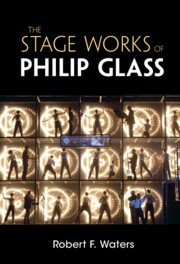Book contents
- The Stage Works of Philip Glass
- The Stage Works of Philip Glass
- Copyright page
- Dedication
- Contents
- Figures
- Tables
- Music Examples
- Selected Stage Works of Philip Glass
- Preface
- Acknowledgments
- Part I Background
- Chapter 1 Introduction
- Chapter 2 Terminology and Stages of Minimalism
- Chapter 3 Terminology: Post-Minimalism, Postmodernism, and Neo-Romanticism
- Chapter 4 Philip Glass’s Early Life and Career, 1937–1975
- Part II Stage Works
- Notes
- Select Bibliography
- Index
Chapter 3 - Terminology: Post-Minimalism, Postmodernism, and Neo-Romanticism
from Part I - Background
Published online by Cambridge University Press: 21 July 2022
- The Stage Works of Philip Glass
- The Stage Works of Philip Glass
- Copyright page
- Dedication
- Contents
- Figures
- Tables
- Music Examples
- Selected Stage Works of Philip Glass
- Preface
- Acknowledgments
- Part I Background
- Chapter 1 Introduction
- Chapter 2 Terminology and Stages of Minimalism
- Chapter 3 Terminology: Post-Minimalism, Postmodernism, and Neo-Romanticism
- Chapter 4 Philip Glass’s Early Life and Career, 1937–1975
- Part II Stage Works
- Notes
- Select Bibliography
- Index
Summary
New York Times critic John Rockwell initially used the term “post-minimalist” in 1981 to describe “using repetition of texture rather than structure,” in contrast to minimalist works, which contains repetition for structural reasons. Post-minimalist music often contains tonal, quasi-tonal, or modal elements, while minimalist elements are often subdued in the background and used for stylistic purposes. The label “neo-Romanticism” often refers to compositional elements that go beyond those found in post-minimalist works in that characteristics of nineteenth-century music appear, including teleological buildup, harmonic tension and release, and contrasting dynamics. The term “postmodernism” often describes post-minimalist works that are fragmented and make use of bricolage, pastiche, collage, and montage. Postmodernist thinking tended to mistrust binary systems, and composers instead maintains a preference for multiple meanings, a condoning of commodification instead of “art for art’s sake,” an emphasis on the virtual world, particularly in multimedia works, and randomization, in part borrowed from composer–philosopher John Cage during the 1950s as well as the Dada movement of the post–World War I era. This chapter will argue that Glass’s stage works can be considered post-minimalist and at times postmodern.
- Type
- Chapter
- Information
- The Stage Works of Philip Glass , pp. 29 - 44Publisher: Cambridge University PressPrint publication year: 2022



